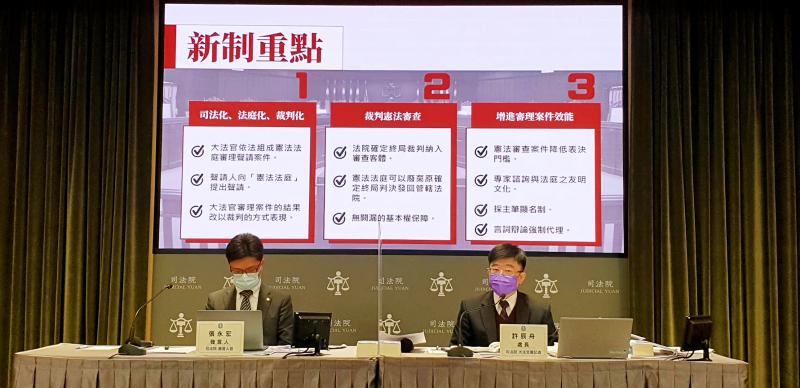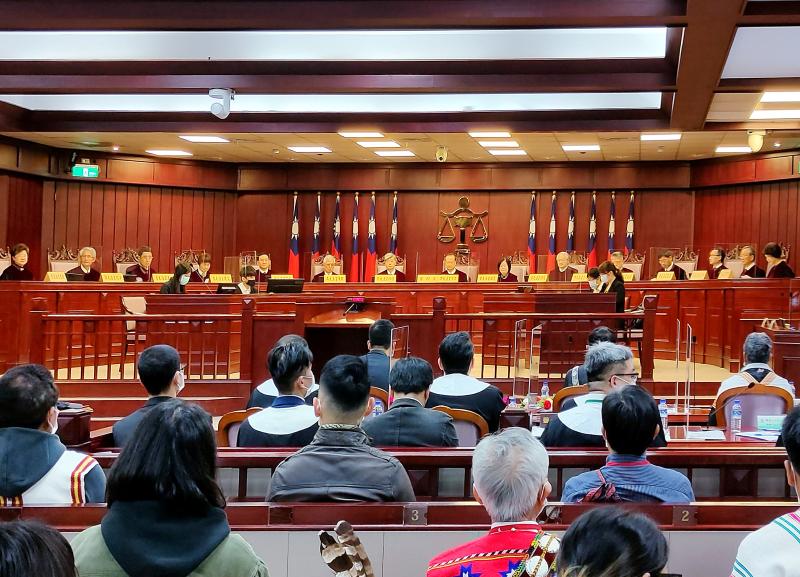The Constitutional Court Procedure Act takes effect today, replacing the Constitutional Interpretation Procedure Act, making Interpretation No. 813 the last Judicial Yuan interpretation. Taiwan’s system of constitutional interpretations, implemented 73 years ago, has come to an end.
Under the new system, a constitutional court comprised of 15 Grand Justices will replace the Council of Grand Justices of the old system. The new courts will hear constitutional litigation with a procedure similar to that of court proceedings, and decisions will be now known as judgements, rather than interpretations.
The difference between the old and the new system is that in addition to examining whether a law or regulation is unconstitutional, it can also examine whether a judgement itself is unconstitutional. According to the Judicial Yuan, people who believe that the laws applied in a ruling or the ruling itself are unconstitutional can apply for a review within six months of receiving the ruling.

Photo: Yang Kuo-wen, Liberty Times 照片:自由時報記者楊國文
The purpose of the new constitutional litigation system is to improve Taiwan’s constitutional review system, said Hsu Chen-chou, Chief Justice Clerk of the Judicial Yuan. The object of the constitutional review by the Grand Justices has now expanded to include the final decisions, along with the existing review of the constitutionality of law and regulations, hoping to better protect people’s rights compared to the former system.
With a total of 95 articles, the Constitutional Court Procedure Act includes many major changes, such as the introduction of the “constitutional complaint concerning a judgment” adopted from the German system, lowering the voting threshold for constitutional review cases, and allowing for the court to make public the claims it receives, in the public interest.
Another innovative change is to refer to the US Supreme Court’s amicus curiae provision, in which any person, authority or association, other than the parties involved, who considers themselves having an interest in a case pending before the Constitutional Court, may make a motion to the court to serve as an amicus curiae and appoint a representative to provide expert opinion of reference value to the court.

Photo: Wu Cheng-feng, Liberty Times 照片:自由時報記者吳政峰
(Translated by Lin Lee-kai, Taipei Times)
《憲法訴訟法》於今日正式實施,取代原本的《大法官審理案件法》,為施行七十三年的釋憲制度畫下句點,釋字八一三號解釋成為大法官最後一號解釋。
此新制是由司法院十五位大法官組成「憲法法庭」,取代之前的「大法官會議」,讓審理程序全面司法化、法庭化,以裁判方式宣示或公告審理結果。
新舊制不同處是除審查是否違憲,還可以審查確定裁判是否違憲。司法院指出,民眾若認為確定判決適用法律、或裁判本身違憲,應在收受判決後六個月內提出聲請。
司法院大法官書記處長許辰舟指出,憲法訴訟新制的目的,是要完善我國的憲法審查制度,大法官憲法審查的客體,從原本的法律、命令,藉由新制,擴及法院確定判決,盼帶給民眾短缺漏的基本權保障。
《憲法訴訟法》共有九十五個條文,其中有多項重大變革,例如參考德國引進「裁判憲法審查」制度,同時調降憲法審查案件表決門檻、主動公開受理案件的聲請書,兼顧民眾知的權益。
另一項創新規定,是參考美國聯邦最高法院「法庭之友」(amicus curiae)立法例,由當事人以外的人民、機關或團體,得主動以書面敘明其與憲法法庭審理案件的關聯性,獲裁定許可成為法庭之友後,委任代理人提出具參考價值的專業意見,供法庭審理參考。
(自由時報記者楊國文)

Photographer Franziska Stuenkel likes to take spontaneous urban shots, so she needs a nimble camera that is ready to go when inspiration strikes: her German-made Leica M11. “I have to be very quick and discreet,” said the Berlin-based artist who captures reflections of people walking past windows, their contours merging with the shapes behind the glass. Stuenkel’s compact Leica is the perfect camera for the job, the 51-year-old told AFP. Famous for its pocket-sized and retro-style devices, the Leica brand is celebrating a milestone as it marks 100 years since its first commercial camera was presented to the public. The

As global travel rebounds following the COVID-19 pa ndemic, the longstanding issue of overtourism has returned stronger than ever. Throughout 2024, numerous popular destinations worldwide struggled with tourist numbers that far exceeded their infrastructural and environmental capacities. Not only does this surge congest streets and pollute landscapes, but it also endangers cultural sites and disrupts the daily lives of residents. In response to the growing problem of “overtourism,” various nations have adopted diverse strategies, some of which have sparked controversy. Venice, Italy, has not hesitated to take bold action; since 2024, the city has implemented one of the

A: This year’s Met Gala, the Metropolitan Museum of Art’s fundraiser, is coming on the first Monday of May. B: The event, featuring a lineup of stars, is often praised as fashion’s Oscars. A: Some Asian stars, like Taiwanese pop diva Jolin Tsai, have also attended in the past. B: What are the theme and dress code this time? A: This year’s theme is “Superfine: Tailoring Black Style.” It’s the first time since 2003 that the theme is focusing on menswear. The dress code is “Tailored for You.” A: 哇今年的大都會博物館慈善晚宴「Met Gala」,即將在5月第一個星期一登場。 B: 這可是被譽為「時尚奧斯卡」的年度盛事,許多巨星都會參加耶。 A:

1. 錢已經用一半了。 ˇ Half of the money is gone. χ Half of the money are gone. 註:Half of ... 作主詞時,動詞與介詞 of 後面的名詞或代名詞相一致,即名詞或代名詞是單數時,動詞該是單數;若為複數,則動詞也該是複數,例如: Half of the story is interesting. Half of the stories are interesting. Half of it is interesting. Half of them are interesting. 2. 許多人走過這條路。 ˇ Many a man has travelled this road. χ Many a man have travelled this road. 註:many a 意義上雖然作 many 解,但後面應跟單數名詞,動詞也用單數形式。 3. 敵人被迫投降。 ˇ The enemy were forced to surrender. χ The enemy was forced to surrender. 註:enemy 作為總稱,前面須有定冠詞,用作句子主詞時,動詞通常用複數形。類似的情形如 talent: Taiwan is known for its semiconductor technology and is actively working to attract and retain global talent. 4. 他倆誰都不該責怪。 ˇ Neither of them is to blame. χ